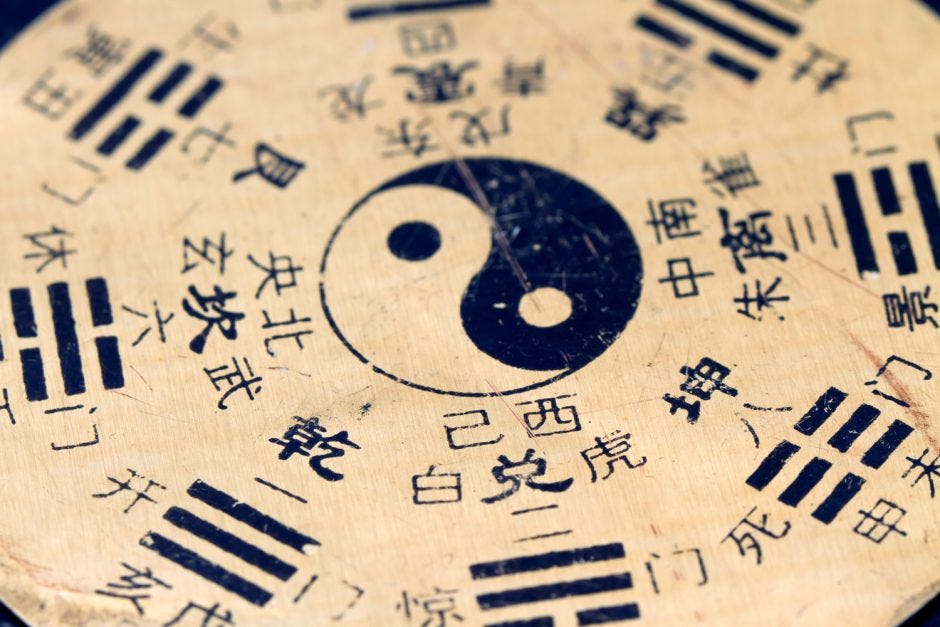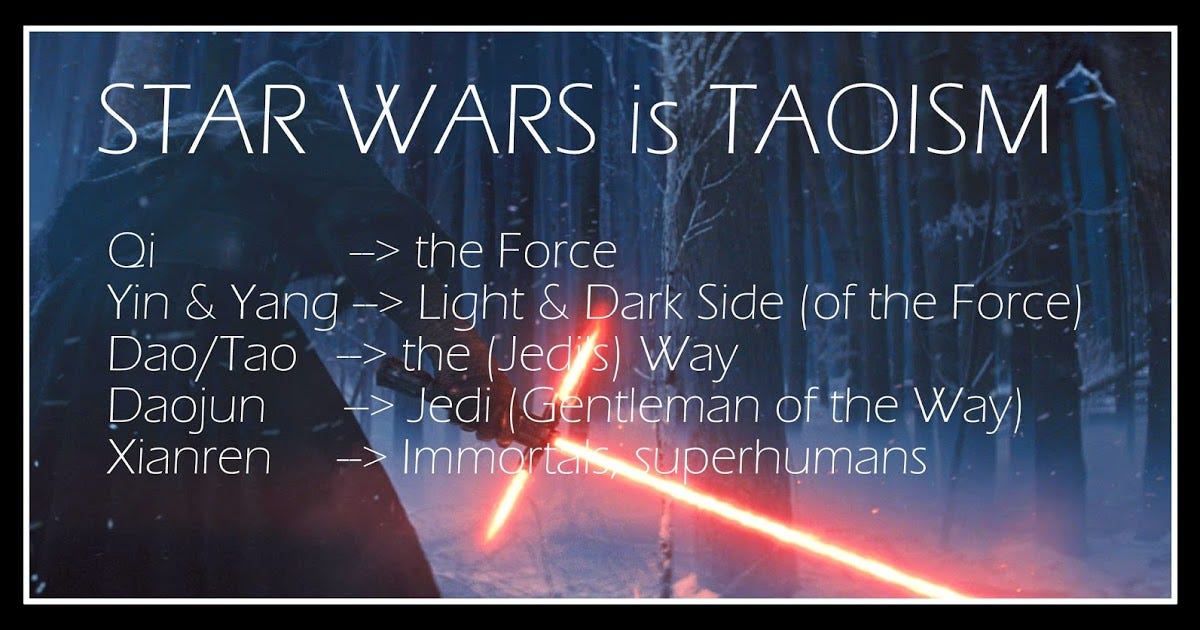
A Sense of Doubt blog post #2122 - Be Like Water - Taoism the philosophy of flow
“In the West,” the I Ching, or the Book of Changes, “is mainly known as a divination manual,” writes philosopher and novelist Will Buckingham, “part of the wild carnival of spurious notions that is New Age spirituality.” But just as one can use the Tarot as a means of reading the present, rather than predicting future events, so too can the I Ching serve to remind us, again and again, of a principle we are too apt to forget: the critical importance of non-action, or what is called wu wei in Chinese philosophy.
Non-action is not passivity, though it has been mischaracterized as such by cultures that overvalue aggression and self-assertion. It is a way of exercising power by attuning to the rhythms of its mysterious source. In the religious and philosophical tradition that became known as Taoism, non-action achieves its most canonical expression in the Tao Te Ching, the classic text attributed to sixth century B.C.E. thinker Laozi, who may or may not have been a real historical figure.
The Tao Te Ching describes non-action as a paradox in which dualistic tensions like passivity and aggression resolve.
That which offers no resistance,
Overcomes the hardest substances.
That which offers no resistance
Can enter where there is no space.
Few in the world can comprehend
The teaching without words, or
Understand the value of non-action.
Wu wei is sometimes translated as “effortless action” or the “action of non-action,” phrases that highlight its dynamic quality. Arthur Waley used the phrase “actionless activity” in his English version of the Tao Te Ching. In the short video introduction above, “philosophical entertainer” Einzelgänger explains “the practical sense” of wu wei in terms of that which athletes call “the zone,” a state of “action without striving” in which bodies “move through space effortlessly.” But non-action is also an inner quality, characterized by its depth and stillness as much as its strength.
Among the many symbols of wu wei is the action of water against stone—a graceful organic movement that “overcomes the hardest substances” and “can enter where there is no space.” The image illustrates what Einzelgänger explains in contemporary terms as a “philosophy of flow.” We cannot grasp the Tao—the hidden creative energy that animates the universe—with discursive formulas and definitions. But we can meet it through “stillness of mind, curbing the senses, being humble, and the cessation of striving, in order to open ourselves up to the workings of the universe.”
The state of “flow,” or total absorption in the present, has been popularized by psychologists in recent years, who describe it as the secret to achieving creative fulfillment. Non-action has its analogues in Stoicism’s amor fati, Zen’s “backward step,” and Henri Bergson’s élan vital. In the Tao te Ching, the Way appears as both a metaphysical, if enigmatic, philosophy and a practical approach to life that transcends our individual goals. It is an improvisatory practice which, like rivers carving out their beds, requires time and persistence to master.
In a story told by Taoist philosopher Zhuangzi, a renowned butcher is asked to explain his seemingly effortless skill at carving up an ox. He replies it is the product of years of training, during which he renounced the struggle to achieve, and came to rely on intuition rather than perception or brute force. Embracing non-action reveals to us the paths down which our talents naturally take us when we stop fighting with life. And it can show us how to handle what seem like insoluble problems by moving through, over, and around them rather than crashing into them head on.
 |
| The yin, the dark swirl, is associated with shadows, femininity, and the trough of a wave; the yang, the light swirl, represents brightness, passion and growth. |
https://medium.com/novasemita/the-philosophy-of-flow-taoism-f176f1de2999
The Philosophy Of Flow — Taoism
We’re sure you’ve heard about Taoism before, but what is it all about?
“That which offers no resistance, overcomes the hardest substances. That which offers no resistance can enter where there is no space.
Few in the world can comprehend the teachings without words, or understand the value of non-action”
Lao Tzu, Tao Te Ching, Chapter 43.
There’s no proof that he truly ever lived. But if he did, it should have been somewhere around the 5th and 6th century B.C which makes him a contemporary of Confucius. Lao Tzu wrote a masterpiece called Tao Te Ching, which is the main work of Taoism.
A well-known concept that has emerged from Taoist philosophy is Wu Wei, that can be translated as “non-action” , “effortless action” or the paradoxical “Action of non-action”. In a practical sense, we can describe Wu Wei as the state of flow, often referred to as the “the zone” by athletes. When athletes are in zone, they engage in action without striving, and move through time and space effortlessly. There are no extremes, no worries, no ruminations, everything seems to flow in a natural course.
“Knowing others is Intelligence, Knowing Yourself is true wisdom,
Mastering others is Strength, Mastering Yourself is true Power”
- Lao Tzu
Taoism is a philosophy of flow. Taoist philosophy emphasis on living with the Tao, also called Way.
So what is the Tao?
That is a question we can’t really answer, and it’s futile to try. Our understanding of the Tao only goes as far as limitation of our perception. What the Tao really is remains a mystery.
“The Tao” is indefinable. Each person can discover the Tao on their terms. A teaching like this can be very hard to grasp when most people desire very concrete definitions in their own life.
The famous opening of the Tao Te Ching goes like this:
“The Tao that can be described is not the eternal Tao. The name that can be spoken is not the eternal Name”.
Taoist philosophers emphasize over and over again that true Tao is an all-encompassing force that is beyond our comprehension and cannot be perceived by the senses. Even though we can never grasp the true Tao, the goal is live in agreement with it, which is strikingly similar to the stoic approach to nature.
So how does one live in harmony with the way?
Taoist literature doesn’t really give one practical method to achieve this. However, we can find many clues that point to achieving stillness of mind, curbing the senses, being humble, and the cessation of striving, in order to open ourselves up to the working of universe. We need to spend time cultivating our Yin which is our inner experience. This stillness of mind doesn’t necessarily mean that we sit down somewhere with our eyes closed. Stillness of mind can be combined with action, and if we are completely in the present moment, our actions will go effortlessly, without friction and accompanied by a razor sharp focus.

Another essential teaching of Taoism is power of gentleness. By forcing and striving, we might get the job done, but at the same time we spend much more energy than necessary and possibly suffer from collateral damage. On the other hand, someone in a state of flow approaches a task intelligently, knowing when to act, and finds a balance between action and non-action. It’s a golden path between anxiety and boredom. The idea behind non-action goes against the Western ideal of forcing and working harder to get results. We are encouraged to be ambitious, to take control and to strive. Meanwhile many people suffer from depression, anxiety disorders and sleep disorders. Are we burning ourselves out? We look down on passivity, and often mistake it for laziness. When we look at nature, ‘doing nothing’ makes way more sense than we tend to think. Results do not equal the amount of energy we spend. Results are the consequences of a series of actions. Many of this action come naturally and a task doesn’t need more human intervention than necessary to steer it into the right direction. Isn’t it so many problems solve themselves?
Taoism compares life with a river. The river already has a course or several courses, and once we find ourselves in that river, we can swim against the current, we can hold on to a branch or we can let go and go along with stream. Most of our lives we swim against the current and we don’t even realize it. Our mind believes that it can and should control the environment, in order to survive, which is kind of egocentric because the vast majority of processes within as well as outside ourselves are not in our control. Taoist way is rather navigating through the river instead of trying to control it. Another aspect of the river that characterizes Taoism is the water itself. The characterization of water are softness and humility that basically symbolize Taoist virtue.
The supreme good is like water, which benefits all of creation without trying to compete with it.
It gathers in unpopular places.
Thus, it is like Tao.
Lao Tzu, Tao Te Ching, Chapter 8
Water may be soft, but it overcomes hardness which can see in the erosion of rock. And water not only seeks the lower places, it has no purpose, no goal, no specific desire. Yet it nourishes everything thing possible.
Water is the softest and most yielding substance. Yet nothing is better than water, for overcoming the hard and rigid, because nothing can compete with it.
Lao Tzu, Tao Te Ching, Chapter 78
If you ever experienced a state of flow, there’s one thing that disappears and only comes back when thinking mind takes back control. This is the focus on results, rather than task in hand. When you are in state of flow, you forget results, the pressure, the anxieties about the future, the failing of the past. It’s just you and the task in hand. You are completely in the present and only way to do this, is by letting go. Letting go means stops swimming against the current, stop holding on to some branches. It means letting go of the past, letting go of the future, focus on this moment entirely and just live it without hesitation.
.jpg)

+++++++++++++++++++++++++++++++++++++++++++++++++++++++++++++++++++++++
+++++++++++++++++++++++++++++++++++++++++++++++++++++++++++++++++++++++
+++++++++++++++++++++++++++++++++++++++++++++++++++++++++++++++++++++++
- Bloggery committed by chris tower - 2012.09 - 10:10
- Days ago = 1986 days ago
- New note - On 1807.06, I ceased daily transmission of my Hey Mom feature after three years of daily conversations. I plan to continue Hey Mom posts at least twice per week but will continue to post the days since ("Days Ago") count on my blog each day. The blog entry numbering in the title has changed to reflect total Sense of Doubt posts since I began the blog on 0705.04, which include Hey Mom posts, Daily Bowie posts, and Sense of Doubt posts. Hey Mom posts will still be numbered sequentially. New Hey Mom posts will use the same format as all the other Hey Mom posts; all other posts will feature this format seen here.





No comments:
Post a Comment